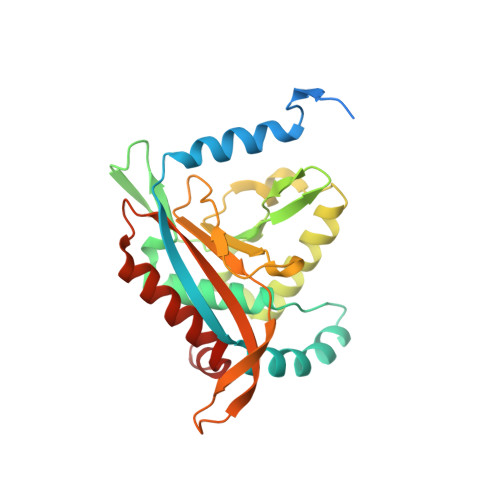A synchronized substrate-gating mechanism revealed by cubic-core structure of the bovine branched-chain alpha-ketoacid dehydrogenase complex.
Kato, M., Wynn, R.M., Chuang, J.L., Brautigam, C.A., Custorio, M., Chuang, D.T.(2006) EMBO J 25: 5983-5994
- PubMed: 17124494
- DOI: https://doi.org/10.1038/sj.emboj.7601444
- Primary Citation of Related Structures:
2IHW, 2II3, 2II4, 2II5 - PubMed Abstract:
The dihydrolipoamide acyltransferase (E2b) component of the branched-chain alpha-ketoacid dehydrogenase complex forms a cubic scaffold that catalyzes acyltransfer from S-acyldihydrolipoamide to CoA to produce acyl-CoA. We have determined the first crystal structures of a mammalian (bovine) E2b core domain with and without a bound CoA or acyl-CoA. These structures reveal both hydrophobic and the previously unreported ionic interactions between two-fold-related trimers that build up the cubic core. The entrance of the dihydrolipoamide-binding site in a 30-A long active-site channel is closed in the apo and acyl-CoA-bound structures. CoA binding to one entrance of the channel promotes a conformational change in the channel, resulting in the opening of the opposite dihydrolipoamide gate. Binding experiments show that the affinity of the E2b core for dihydrolipoamide is markedly increased in the presence of CoA. The result buttresses the model that CoA binding is responsible for the opening of the dihydrolipoamide gate. We suggest that this gating mechanism synchronizes the binding of the two substrates to the active-site channel, which serves as a feed-forward switch to coordinate the E2b-catalyzed acyltransfer reaction.
Organizational Affiliation:
Department of Internal Medicine, University of Texas Southwestern Medical Center, 5323 Harry Hines Boulevard, Dallas, TX 75390, USA.
















